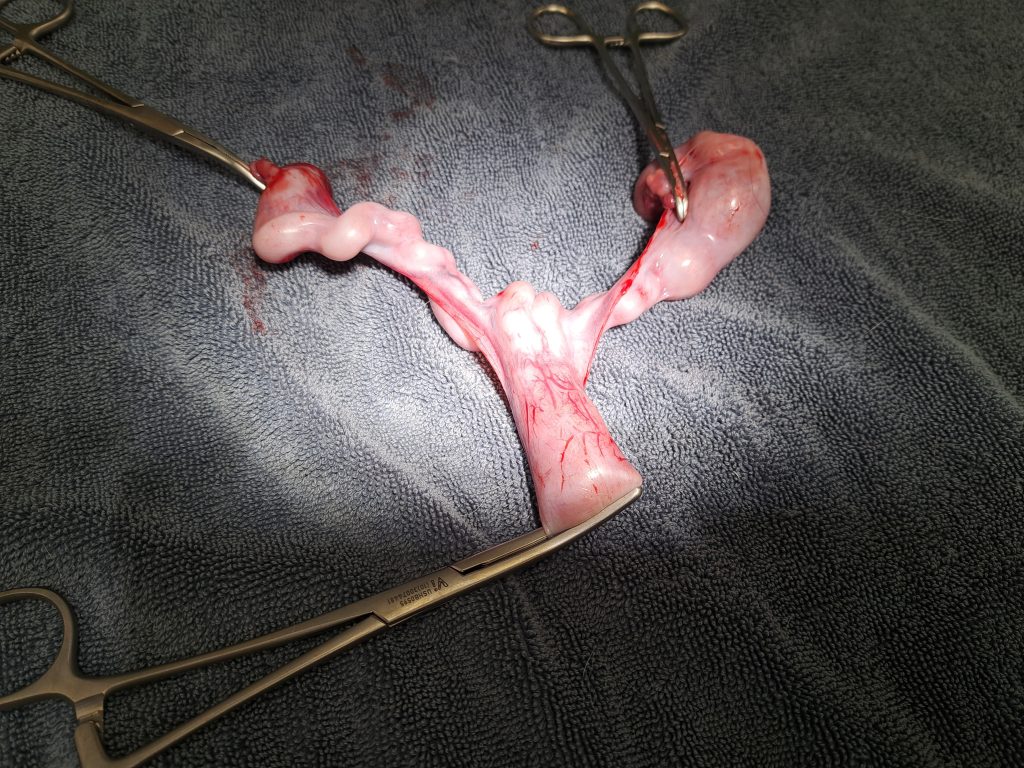This is the pus filled uterus that I surgically removed from a 1 year old cat this morning. It weighed 1/2 a pound, which in this 6.2 pounds cat, represented 8.3% of her overall body weight. If this were average sized person, that would be equivalent to carrying around a 12 pound pus filled visceral structure inside his/her abdomen. This condition is called pyometra, an infection within the uterus that leads to pus filling the uterus, that occurs in both intact female dogs and cats. This is a surgical emergency that is invariably fatal if not treated quickly.
What Causes Pyometra in Dogs & Cats?
Pyometra is caused by bacteria entering the uterus. Normally, the cervix is closed, which helps prevent bacteria from getting into the uterus. However, when a pet goes into heat, the cervix relaxes to let in sperm. Her body also releases the hormone progesterone, which causes the lining of her uterus to thicken to get ready for pregnancy.
If the pet doesn’t get pregnant after several cycles, the lining of her uterus may continue to thicken. This makes it easier for cysts to form along the uterine lining. This thick, cystic lining secretes fluid that allows bacteria to grow within the uterus. The pet’s immune system would normally release white blood cells to fight bacteria, however, during heat, white blood cells are suppressed from going into the uterus so that sperm won’t be damaged by them.
High progesterone levels also prevent the muscles in the wall of the uterus from contracting. These contractions would normally help the uterus get rid of extra fluid and bacteria.
What Are the Symptoms of Pyometra in Dogs & Cats?
The symptoms of feline pyometra can vary from pet to pet. Some pets may seem very ill, while some may just have pus in their vaginal discharge. Any pet who hasn’t been spayed and is ill should be checked for pyometra. Some of the more common symptoms include:
- Not eating
- Urinating a lot
- Drinking a lot
- Lethargy
- Depression
- Bloody or pus discharge from the vagina
Some symptoms that aren’t as common include:
- Vomiting
- Diarrhea
- Weight loss
- Inflamed eyes
- Swollen abdomen
How is Pyometra in Dogs & Cats Diagnosed?
If your pet’s cervix is open and she has a discharge with pus in it, that is a strong indication that your pet may have pyometra. If your pet’s cervix is closed, there may not be a discharge, so the vet may need to do more tests. Some tests that your vet may do are:
- General chemistry profile, which is a blood test that gives your vet general information about how your pet’s organs are functioning
- Complete blood count, which tests the cells that make up your pet’s blood
- Urinalysis
- Abdominal X-rays
- Abdominal ultrasound
Treatment is surgical removal of the reproductive tract, as the infection cannot be cleared effectively with antibiotics. Pre and post-operatively, the patient is supported with antibiotics, IV fluids, and will be discharged on antibiotics and post-operative pain medication. It the uterus has already ruptured prior to diagnosis and spilling pus into the sterile abdomen, in addition to surgical removal of the uterus and flushing of the abdominal cavity, several days of hospitalization may be necessary to treat subsequent peritonitis and possible sepsis.
The best way to deal with pyometra, however, is prevent it in the first place and having your dog or cat spayed!


